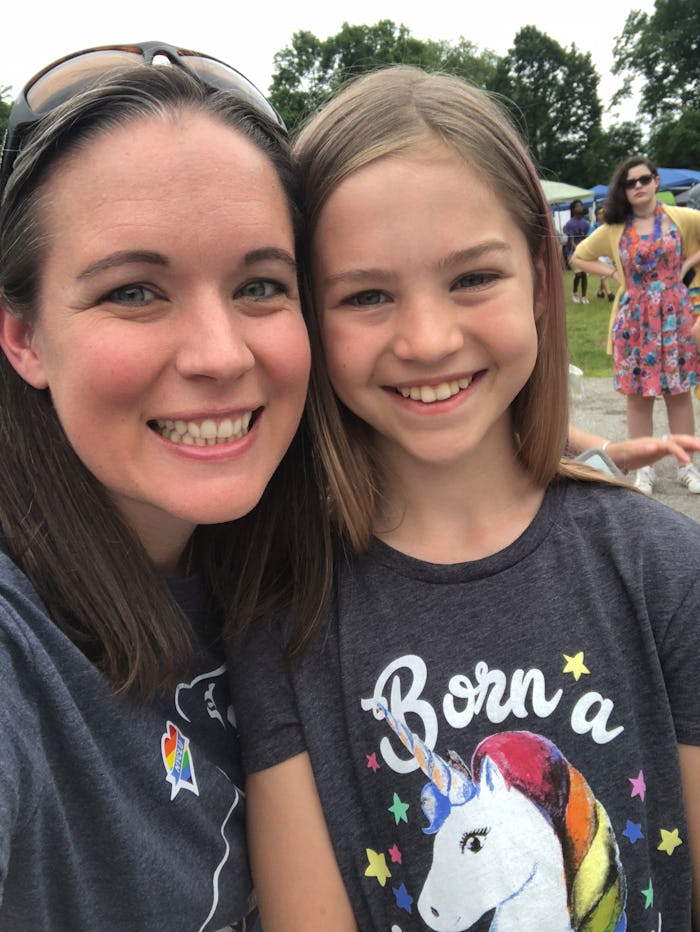Life

Why Pride Feels Different This Year
A year ago, my family found ourselves decked out in rainbows, sequins, and smiles riding on a float in a small town Pride parade in Warwick, N.Y. My now-12-year-old daughter was Grand Marshall, a honor given to her in thanks for her advocacy for transgender kids. My husband, a pastor at a local Lutheran church, wore his clergy collar along with a rainbow shirt, while I proudly wore my “mama bear” t-shirt with a roaring bear and her cub colored in with the pink, blue, and white of the transgender flag. My sons, ages 5 and 10, sat on hay bales by our side, and we all waved at rainbow-clad spectators until we thought our arms would fall off. It was a beautiful day filled with sunshine, laughter, dancing, and celebrating. But I have a confession. It was my first Pride festival, and it was really uncomfortable.
We have spent the past few years showing up at protests and rallies, channeling our heartache and rage over the attacks on the LGBTQ+ community into demands for policy, relentless education, and defiant visibility. With fire in my belly, I have talked to crowds gathered in the streets and on the steps of the State House. I have shared my family’s story with legislators and testified at legislative hearings. I have trained educators, advised school boards, and preached in faith communities. My kids and I have sat at the kitchen table making protest sign after protest sign. We got really good at getting angry and making things happen. This Pride festival was different. I didn’t know what to do. My kids didn’t know what to do. They were used to protests. Where were the chants of “this is what democracy looks like”? They knew how to rally, but they didn’t understand this big party.
They stared in amazement, not because folks were showing up proudly in their identities — they were used to that part. They stared in amazement because everyone was celebrating. While there was usually laughter and fun when we gathered with LGBTQ+ communities to do the work we did, there was also often an undercurrent of anxiety, of heartbreak. We were really good at finding hope, joy, and solace in the face of really hard things. This particular Pride celebration had no undercurrent. It was just pure joy. It was a safe space where we could pause our fight for gender and sexual identities for a moment and simply celebrate them. Giant balloon swords clashed by my side as my boys battled, and I watched my daughter’s rainbow sequin skirt sparkle in the sunshine as she walked away with friends to go explore and have fun. They screen-printed their own t-shirts, made buttons, ooh-ed and aah-ed over everyone’s outfits, and then climbed some trees. She didn’t have to be an activist. She was just a kid. She shared a few words from the stage as Grand Marshall, but even those felt a little off. They were rooted in resistance and inspired action, and this community had put that aside for the day. Today was like a giant exhale. It was a day of simply being.
I take my family to Pride because it’s important to me as a newly out queer person to have by my side my cisgender straight clergy spouse, my transgender daughter, and my younger sons.
This year, we celebrate the 50th anniversary of the Stonewall Riots, widely considered the birth of the LGBT equality movement. Pride started as a riot, a wildly courageous act of resistance led by trans women of color. Today, we honor their bravery, boldness, and sacrifice both with our commitment to queer liberation and with our joy-filled celebration of queer identities. This is why I’m committed to taking my kids to Pride events of all kinds.I will take them to Pride festivals, because I also take them to protest, advocate, rally, and fight for equality.
I want them to see what they are protesting, rallying, and fighting for and what that work has brought us. I teach them about where Pride started, because my daughter needs to know why she gets to live the life she does as a transgender young person and about the activists whose shoulders we stand on when we fight. I take my young boys to pride because I want them to know that whoever they are, whoever they may grow up to be, that they are worthy of celebration. I take them to Pride so they can celebrate all kinds of humans. This is the first year I’ll celebrate Pride as an openly queer person. I came out as bisexual last summer. I take my family to Pride because it’s important to me as a newly out queer person to have by my side my cisgender straight clergy spouse, my transgender daughter, and my younger sons, who have plenty of time to grow into and share with us whoever they may be.
Pride started as a riot, but this year it feels like a moment to exhale, a moment to set down our protest signs and be defiantly joyful, defiantly hopeful, and defiantly visible. There is no shortage of heartache, rage, and injustice. There is plenty of work to be done, and if I’m being honest, I’m far more comfortable doing the work. But I’m going to take a moment and embrace the radical act of joyful resistance that is Pride. I’m going to spend this month celebrating as often as I can so my kids can see the full brilliance, joy, and hope in this community.
This article was originally published on